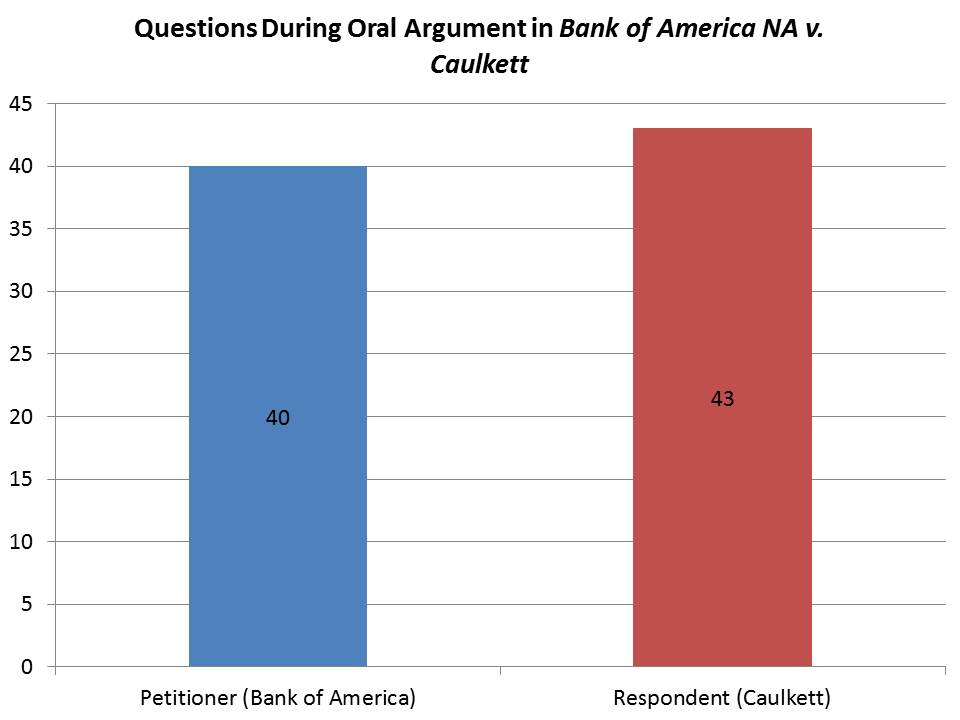The Supreme Court heard oral argument two cases on Monday. I’m predicting the winners based on the method of counting up the number of questions. Both of today’s cases are difficult to predict based on the question count.
The first case is an important First Amendment case, Walker v. Texas Division, Sons of Confederate Veterans, which asks (1) whether the messages and images that appear on state-issued specialty license plates qualify as government speech immune from any requirement of viewpoint neutrality; and (2) whether Texas engaged in “viewpoint discrimination” by rejecting the license-plate design proposed by the Sons of Confederate Veterans, when Texas has not issued any license plate that portrays the confederacy or the confederate battle flag in a negative or critical light.
Figure 1.

As Figure 1 shows, the total question count slightly favors the Petitioner (Texas SG), which received 5 fewer questions than Respondent (Sons of Confederate Veterans).
The question count by individual Justice presents a mixed picture, however. Chief Justice Roberts and Justice Kagan asked the Petitioner 6 more questions–which suggests they are leaning to the Respondent. Justices Ginsburg and Sotomayor asked the Respondent 6 more questions–which suggests they are leaning to the Petitioner. Justice Kennedy also asked the Respondent 3 more questions, but he’s been less predictable based on his question count. Justice Breyer asked the Respondent 2 more questions, a small differential.
Meanwhile, Justices Scalia and Alito asked both sides the same number of questions (11 and 5 questions, respectively). Given these numbers, I think the case is tough to call based on simply the question count. But my guess would be that Justices Scalia and Alito join Roberts and Kagan, who appear to be leaning to the Respondent’s side, which argued for affirmance of the Fifth Circuit’s decision holding that Texas’s denial of vanity license plates for Respondent’s Confederate flag violated the First Amendment. I will give the edge to the Respondent.
The second case, San Francisco v. Sheehan, asks “(1) whether Title II of the Americans with Disabilities Act requires law enforcement officers to provide accommodations to an armed, violent, and mentally ill suspect in the course of bringing the suspect into custody; and (2) whether it was clearly established that even where an exception to the warrant requirement applied, an entry into a residence could be unreasonable under the Fourth Amendment by reason of the anticipated resistance of an armed and violent suspect within.”
This case is difficult to predict for several reasons. First, it is an asymmetrical case with the Petitioner, the Respondent, and the Solicitor General arguing as amicus for vacatur in part and reversal in part. Because the SG is allotted only 10 minutes, one cannot do a simple comparison of the three attorneys’ question counts. Second, Justice Breyer recused, so only 8 Justices will be deciding the case.
Figure 2.

As Figure 2 shows, the Respondent (Sheehan) received 49 questions, while the Petitioner (San Francisco) received 39 questions. This count favors the Petitioner. The SG did not side with the Petitioner, but the SG’s position of partial reversal and vacatur is more favorable to the Petitioner.
The question count by individual Justice also slightly favors the Petitioner’s side. Only Justice Scalia asked the Petitioner more questions. Chief Justice Roberts and Justices Kennedy and Thomas asked no questions to the Petitioner, whereas 7 of the 8 Justices asked questions to the Respondent. Justices Ginsburg, Alito, and Kagan asked the Petitioner fewer questions than the Respondent by small margins (1, 1, and 3 respectively). Justice Sotomayor asked both sides the same number of questions.
Based on these numbers, I will go with a reversal or vacatur of the decision below. It’s too difficult to tell simply based on the question count whether the Court will favor the Petitioner’s or SG’s position, so I will leave it as reversal of some kind.





